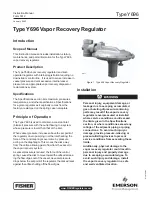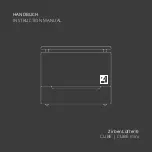
Type Y696
2
1. The pressure/temperature limits in this instruction manual or any applicable standard limitation should not be exceeded.
1. Use qualified personnel when installing, operating,
and maintaining the regulator. Before installing, inspect
the regulator for any shipment damage or foreign
material that may have collected during crating and
shipment. Make certain the body interior is clean and
the pipelines are free of foreign material. Apply pipe
compound only to the male pipe threads.
2. Install the regulator using a straight run of pipe the
same size or larger as the regulator body (as shown in
figure 3). Flow through the regulator body is indicated
by the flow arrow cast on the body. If a block valve is
required, install a full flow valve between the regulator
and the blanketed vessel. For proper operation, the
regulator should be installed with the spring case barrel
pointed down. Key numbers referenced in this section
are shown in figure 4.
A regulator may vent some gas to the
atmosphere. In hazardous or flammable
gas service, vented gas may accumu-
late, and cause personal injury, death, or
property damage due to fire or explo-
sion. Vent a regulator in hazardous gas
service to a remote, safe location away
from air intakes or any hazardous loca-
tion. The vent line or stack opening must
be protected against condensation or
clogging.
3. To keep the spring case vent from being plugged or
the spring case from collecting moisture, corrosive
Body Size and End Connection Style
(1)
See table 1
Maximum Allowable Inlet and Outlet Pressure
(2)
15 psig (1,0 bar)
Outlet Pressure Ranges
See table 2
Specifications
Pressure Registration
Internal
Spring Case and Vent Connections
1/4-inch NPT
Maximum Temperature Capabilities
(2)
Nitrile (NBR):
–20° to 180°F (–29° to 82°C)
Fluoroelastomer (FKM):
0° to 300°F (–18° to 149°C)
E
G
N
A
R
E
R
U
S
S
E
R
P
T
E
L
T
U
O
R
E
B
M
U
N
T
R
A
P
G
N
I
R
P
S
R
O
L
O
C
G
N
I
R
P
S
R
E
T
E
M
A
I
D
E
R
I
W
s
e
h
c
n
i-
5
o
t
2
.
c
.
w
.
c
.
w
s
e
h
c
n
i-
5
1
o
t
5
g
i
s
p
1
o
t
3
.
0
)
r
a
b
m
2
1
o
t
5
(
)
2
(
)
1
(
)
r
a
b
m
7
3
o
t
2
1
(
)
2
(
)
1
(
)
r
a
b
m
9
6
o
t
1
2
(
2
2
0
7
2
1
0
0
2
A
1
2
6
0
7
2
7
7
7
5
B
1
2
5
0
7
2
4
9
1
0
B
0
d
e
R
y
a
r
G
n
e
e
r
G
)
m
m
4
,
3
(
s
e
h
c
n
i-
5
3
1
.
0
)
m
m
0
,
4
(
s
e
h
c
n
i-
6
5
1
.
0
)
m
m
8
,
4
(
s
e
h
c
n
i-
7
8
1
.
0
g
i
s
p
8
.
2
o
t
1
g
i
s
p
5
.
3
o
t
2
g
i
s
p
7
o
t
4
)
r
a
b
9
1
,
0
o
t
9
6
0
,
0
(
)
r
a
b
4
2
,
0
o
t
4
1
,
0
(
)
r
a
b
8
4
,
0
o
t
8
2
,
0
(
2
0
2
7
2
1
1
8
0
A
0
2
2
0
7
2
4
6
6
0
Y
0
2
A
0
0
0
4
2
0
8
H
1
e
g
n
a
r
O
e
p
ir
t
s
n
e
e
r
G
r
e
v
li
S
)
m
m
4
,
6
(
s
e
h
c
n
i-
0
5
2
.
0
)
m
m
2
,
9
(
s
e
h
c
n
i-
3
6
3
.
0
)
m
m
3
,
0
1
(
s
e
h
c
n
i-
6
0
4
.
0
.
)
r
a
b
m
5
(
.
c
.
w
s
e
h
c
n
i-
2
s
e
s
a
e
r
c
n
i
e
g
n
a
r
g
n
ir
p
s
,
p
u
d
e
t
n
i
o
p
d
e
ll
a
t
s
n
i
n
e
h
W
.
n
w
o
d
d
e
t
n
i
o
p
d
e
ll
a
t
s
n
i
e
s
a
c
g
n
ir
p
s
n
o
d
e
s
a
b
s
e
g
n
a
r
g
n
ir
p
S
.
1
.
)
C
°
6
1
(
F
°
0
6
n
a
h
t
r
e
w
o
l
s
e
r
u
t
a
r
e
p
m
e
t
m
g
a
r
h
p
a
i
d
t
a
s
g
n
ir
p
s
e
s
e
h
t
h
ti
w
m
g
a
r
h
p
a
i
d
)
M
K
F
(
r
e
m
o
t
s
a
l
e
o
r
o
u
lf
e
s
u
t
o
n
o
D
.
2
Table 2. Outlet Pressure Ranges
,
E
Z
I
S
Y
D
O
B
)
N
D
(
S
E
H
C
N
I
L
A
I
R
E
T
A
M
Y
D
O
B
n
o
r
I
t
s
a
C
l
e
e
t
S
l
e
e
t
S
s
s
e
l
n
i
a
t
S
C
y
o
ll
e
t
s
a
H
)
0
5
(
2
d
n
a
)
0
4
(
2
/
1
-
1
T
P
N
,
F
R
0
5
1
L
C
,
E
W
S
,
T
P
N
0
4
/
5
2
/
6
1
N
P
,
0
0
3
L
C
,
F
R
0
5
1
L
C
,
E
W
S
,
T
P
N
0
4
/
5
2
/
6
1
N
P
,
0
0
3
L
C
F
R
0
5
1
L
C
Table 1. Body Sizes and End Connection Style


























